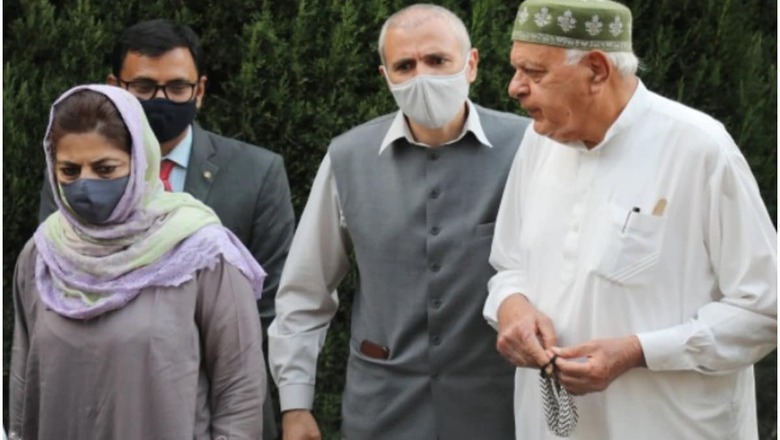
views
Amidst the devastating second wave of the COVID-19 pandemic, there is surprising calm in Jammu and Kashmir (J&K) over the constitutional changes brought in by the Government of India on 5 August 2019. Compared to the corresponding period last year, there appears to be little agitation in the political and popular discourse on the issue. The mention of Article 370 and other allied changes seems to have magically vanished from the political rhetoric of the mainstream parties in Kashmir, as well as of civil society. This lull is by no means an outcome of the pandemic-related fatigue or the fear generated by the disastrous second wave infections. There is now a greater, if not an absolute, normalisation of the monumental changes implemented in J&K in 2019.
Generally, the onset of spring comes with a fresh spike in both street and militancy-related violence in the valley. The last three months have witnessed just a few militant attacks on civilian and military targets—a significant change. The Line of Control (LoC) remains tranquil after the ceasefire announced by the Director Generals of Military Operations (DGMOs) of India and Pakistan in February. Although the anti-militancy encounters continue, militant recruitment has remained a challenge. The security forces for the first time since 2016 have announced a change in strategy: Focusing primarily on preventing the recruitment instead of killing of militants.
It is too early to declare normalisation of things on the security front because the emerging trend of the last few months is not adequate conclusive evidence. But the normalisation on the political front is evident. The thaw between India and Pakistan emanating from the backchannel talks has nailed the coffin of Article 370 and the bifurcation of Jammu and Kashmir.
Multiple news reports emerging after a 7-hour long conversation held by Pakistan’s Army Chief with over two dozen of Pakistan’s top journalists confirms this fact. As per an article published in The Indian Express, the army chief has categorically stated that Article 370 is not an issue of concern for Pakistan. He laid strong emphasis on the restoration of statehood and on ensuring that no demographic change is allowed. An article published in the Pakistani newspaper, Dawn, corroborates this fact. Perhaps, the most consequential development is the absence of any mention of the bifurcation of the erstwhile state of Jammu and Kashmir.
Days after yjr Army Chief’s Iftar conversation, Pakistan’s Foreign Minister in a TV interview said Article 370 is an “internal matter of India and it meant nothing for Pakistan”. Reiterating the position emerging from a private conversation of the Army Chief, the Minister emphasised Article 35A. Two days later, the Foreign Minister buckled under the pressure of the opposition and made a U-turn which is characteristic of politicians in Pakistan.
Likewise, Prime Minister Imran Khan also issued a statement saying that “No dialogue with India until it reverses 5 August decision.” But there is a catch. It is not clear which of the multiple decisions taken on August 5 does Khan want reversed—The Union Territory status of J&K, Article 370, Article 35A, or the bifurcation of the erstwhile state?
Since the announcement of the ceasefire, an epidemic of confusion has afflicted Islamabad. It is important to note that the Government of Pakistan is finding it increasingly difficult to justify or rationalise the compromise that its masters are seeking. Given the high-octane propaganda and vicious rhetoric unleashed by Imran Khan and his cabinet post-August 5, a climbdown is becoming increasingly difficult to pull off.
It is, however, safe to assume that despite the comic wriggle of the Imran Khan regime, the backchannel talks are continuing. The first indication of this came after the cabinet in Pakistan overturned the decision of the Economic Coordination Committee (ECC) to import cotton from India. According to news reports coming from Pakistan, the U-turn on normalising trade relation was merely seen as a “bump” by officials in Islamabad and has not derailed the initiative.
No doubt, the twists and turns coming from Pakistan will surely come as a relief for India but it is the ripple effect of U-turns that comes as a huge advantage to the Modi government. The opposition to sweeping amendments in Article 370 and bifurcation has been defanged. There is already a promise of returning the statehood; and a strengthening of domicile laws in J&K would not be seen as a compromise by the Indian population or Modi’s support base.
Within Jammu and Kashmir, this new reality has also dawned on the mainstream political parties, particularly the National Conference and Peoples Democratic Party (PDP), which got into agitational mode after the release of their leaders. The silence of mainstream parties is partly enforced through threats of litigation, investigations, and in some cases detention without any charge. All Kashmir-based parties know that the restoration of statehood and strengthening of domicile laws is the only concession they can expect from New Delhi. A message, concurrent with the policy of the government, is well conveyed to their leaders.
Amongst these parties, Mehbooba Mufti and her PDP was perhaps the most agitational in her demands and rhetoric. But the sudden silence from her party on Article 370 and other August 5 decisions is perhaps a symptom of an existential threat to the political future of the party engineered by Delhi. At the same time, Pakistan’s willingness to drop the ball on Article 370 makes a compromise for her party easy to sell to its local constituency. If the mothership of all troubles in Kashmir (read Pakistan) decides to surrender on an issue, why should these parties take the trouble of agitating, risking personal and political interests, for a demand which is unachievable under the current regime?
The thaw between India-Pakistan is normalising and, indeed, formalising the new status quo on Kashmir. The continuation of the status quo in the face of agitations and conflicts is a perpetual feature of the history of India-Pakistan and Kashmir. For all their hemming and hawing of Pakistani hawks against a status quoist solution on Kashmir, the reality is perhaps harsher: New Delhi has turned the corner on August 5, 2019—in Kashmir and internationally as well.
This article was first published on ORF.
Read all the Latest News, Breaking News and Coronavirus News here.




















Comments
0 comment